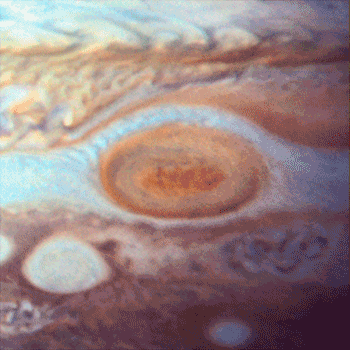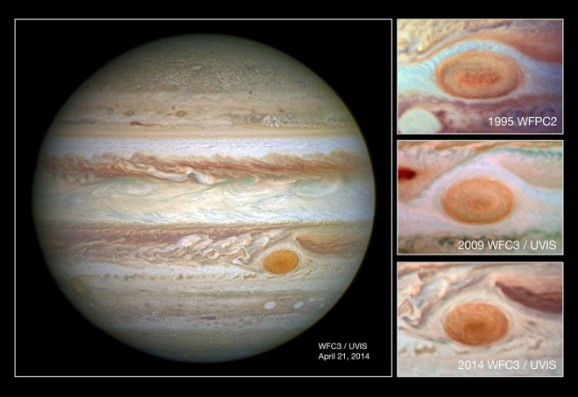Jupiter’s Great Red Spot—Soon To Be A Small Red Spot?
This article is more than 2 years old
 Arthur Clarke had a soft spot for Jupiter and wrote about it often. In A Meeting with Medusa, a crew uses a hot air balloon to descend from their spacecraft to Jupiter’s surface, where they find all kinds of strange stuff, like flying bioluminescent plankton and floating jellyfish a mile wide. In 2001: A Space Odyssey, Jupiter is the destination (at least, in the movie it is), and in 2010: Odyssey Two, Jupiter — and the mysterious monolith orbiting it — is the focus. In what may have been a particularly prescient plot twist, Clarke also describes life forms in the waters of Europa. As the crew explores the Jovian system, a “Great Black Spot” appears on Jupiter, which grows exponentially — a huge swarm of self-replicating monoliths that consume the planet and…well, I won’t tell you. Let’s just say Jupiter is renamed Lucifer. Clarke’s “Great Black Spot” is, of course, a spin on the most distinguishable birthmark on Jupiter. But instead of growing like the Great Black Spot, Jupiter’s Great Red Spot is shrinking.
Arthur Clarke had a soft spot for Jupiter and wrote about it often. In A Meeting with Medusa, a crew uses a hot air balloon to descend from their spacecraft to Jupiter’s surface, where they find all kinds of strange stuff, like flying bioluminescent plankton and floating jellyfish a mile wide. In 2001: A Space Odyssey, Jupiter is the destination (at least, in the movie it is), and in 2010: Odyssey Two, Jupiter — and the mysterious monolith orbiting it — is the focus. In what may have been a particularly prescient plot twist, Clarke also describes life forms in the waters of Europa. As the crew explores the Jovian system, a “Great Black Spot” appears on Jupiter, which grows exponentially — a huge swarm of self-replicating monoliths that consume the planet and…well, I won’t tell you. Let’s just say Jupiter is renamed Lucifer. Clarke’s “Great Black Spot” is, of course, a spin on the most distinguishable birthmark on Jupiter. But instead of growing like the Great Black Spot, Jupiter’s Great Red Spot is shrinking.
Scientists know that the Great Red Spot is a massive cyclone whose winds swirl around at hundreds of miles per hour. The first confirmed sighting was in 1831, and unconfirmed sightings were noted centuries before that, so this storm has been raging a long time. Calculations, at least back then, estimated that the Spot was roughly 25,500 miles across — a size so big it could cover three Earths. About 100 years after it was first observed, scientists began noticing the spot shrinking, and recent Hubble data confirms it — the Spot now seems to be roughly 10,250 miles across. Scientists estimate that it’s shrinking at a rate of approximately 580 miles a year.

Researchers aren’t entirely sure why the Spot is shrinking, but eddies spinning at the storm’s edge might be draining it. “We hypothesized these may be responsible for the accelerated change by altering the internal dynamics and energy of the Great Red Spot,” NASA says. Or maybe something strange is happening with the internal mechanisms of the storm, which has patches that are warmer than others.
The spot also changes color, perhaps due to sulfur molecules being freed from the atmosphere by ultraviolet radiation, or perhaps the changes are due to other chemical and environmental combinations, or even recent meteor impacts. Scientists don’t know if any of those factors would account for its shrinking size, but they’re looking into it. In addition to getting smaller, the Great Red Spot now appears more circular than elliptical. Maybe Juno can help us figure out what’s going on.
The obvious explanation is that the yet-undetected monoliths are siphoning the storm’s strength for their own purposes.












